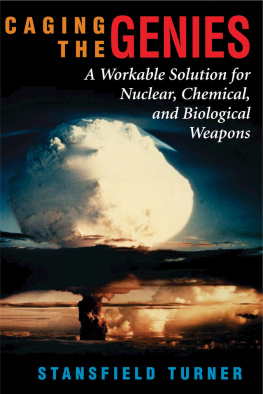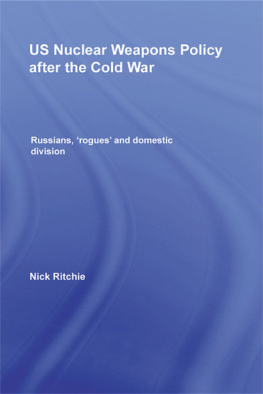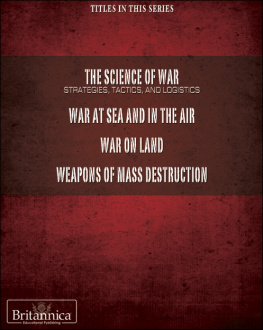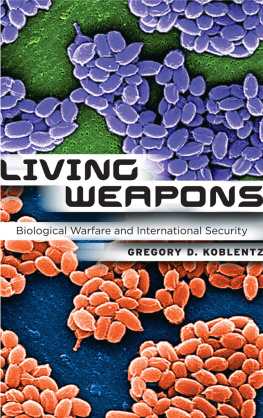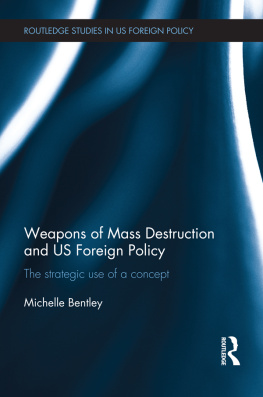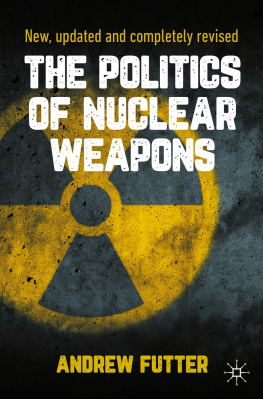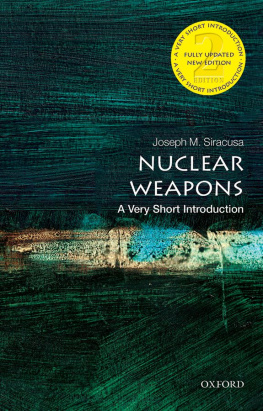First published 1999 by Westview Press
Published 2018 by Routledge
711 Third Avenue, New York, NY 10017, USA
2 Park Square, Milton Park, Abingdon, Oxon OX14 4RN
Routledge is an imprint of the Taylor & Francis Group, an informa business
Copyright 1999 by Taylor & Francis
All rights reserved. No part of this book may be reprinted or reproduced or utilised in any form or by any electronic, mechanical, or other means, now known or hereafter invented, including photocopying and recording, or in any information storage or retrieval system, without permission in writing from the publishers.
Notice:
Product or corporate names may be trademarks or registered trademarks, and are used only for identification and explanation without intent to infringe.
Library of Congress Cataloging-in-Publication Data
Turner, Stansfield, 1923
Caging the genies: a workable solution for nuclear, chemical, and
biological weapons / Stansfield Turner. 2nd ed.
p. cm.
Includes bibliographical references and index.
ISBN 0-8133-6677-1
1. Weapons of mass destruction. 2. Arms control. 3. No first use
(Nuclear strategy). 4. Security, International. I. Turner,
Stansfield, 1923- Caging the nuclear genie. II. Title.
U793.T87 1999
327.1'747dc21
99-13854
CIP
ISBN 13: 978-0-8133-6677-7 (pbk)
Since the original publication of this book in September 1997, concern for the threat that biological and chemical weapons pose has grown. This second edition of Caging the Nuclear Genie, retitled Caging the Genies: A Workable Solution for Nuclear, Chemical, and Biological Weapons, addresses that concern. Chemical and biological weapons are similar enough to nuclear weapons that the three are commonly grouped in a single category: weapons of mass destruction. I found, then, in laying out the problems these weapons pose and the solutions applicable to them, that the structure for dealing with nuclear weapons was quite adequate for dealing with the others also. Thus, analyses of chemical and biological weapons are integrated throughout the text as appropriate.
The original book would not have been feasible without generous grants from the Carnegie Corporation of New York. In addition to being most grateful for that support, I am appreciative of the advice and encouragement there of David Speedie and the late McGeorge Bundy. "Mac's" perceptive work in the area of nuclear weapons was a constant guide and benchmark.
I am also very grateful to the W. Alton Jones Foundation for the grant that gave this project its initial momentum and to George Perkovich for his helpful advice from beginning to end.
This second edition was made possible by The Fourth Freedom Foundation, which provided a generous grant in support of it.
The Norwegian Nobel Institute of Peace kindly provided me a Senior Research Fellowship and a stimulating environment in which to pursue the original effort for six months. They assembled a diverse group to critique the work in progress, including Christoph Bertram of Hamburg and Pavel Baeev of Moscow. Geir Lundestad and Odd Arne Westad of the Nobel Institute offered helpful comments throughout my stay in Oslo.
John Chipman and Rose Gottemoeller of the International Institute of Strategic Studies in London were generous in bringing together a seminar to review an extended outline of the book. That group included some of the most prominent thinkers in this area, including Sir Michael Howard and Lawrence Freedman. I am most grateful to all of them for taking so much of their time.
The Peace Research Institute of Oslo also was kind in organizing a helpful seminar discussion that included Magne Barthe, Nils Petter Gleditsch, and Robert Bathurst.
I have been fortunate in having had assistance with research from a number of individuals during a span of four years. Hanno Kirk, Howard Diamond, Matt Didaleusky, and Jason Pate were able to devote the most time to it and were invaluable both for the facts they uncovered and the advice they proffered. Kurt Wendt, Zach Patrick, Milton Leitenberg, Garrett Ogden, Alex Slesar, and Peter Copeland also provided wonderful support. For this second edition of the book, Jason Pate and Hanno Kirk continued to provide major help and were joined by Erik Leklem, whose help was also most valuable.
Many individuals were kind enough to meet with me and offer suggestions: Robert McNamara, Bill Perry, and Dick Cheney, former secretaries of defense; Admiral Henry Chiles, then commander in chief of the U.S. Strategic Command; General Lee Butler, former commander in chief of the U.S. Strategic Command; Michael Nacht, A1 Lieberman, and Fred Nyland of the U.S. Arms Control and Disarmament Agency; Janne Nolan, John Steinbrunner, Bill Kauffman, and Bruce Blair of the Brookings Institution; Roger Molander, Bruno Augenstein, and Jim Digby of the RAND Corporation; Robert Piacesi and Paul Garvin of G&P Associates, Inc.; Sergei Rogov of the Institute of the USA and Canada Studies in Moscow; James Jacobs of the Federal Emergency Management Agency; Steve Hadley, formerly of the Department of Defense; Bruce Russett and Gaddis Smith of Yale University; Father Brian Hehir of Harvard University; Brigadier Generals Jim Mathers and Lance Lord and Colonels Bob Kehler and Jack Byrnes of the U.S. Space Command; Major General Gary Curtin and Brigadier General Thomas Neary of the U.S. Strategic Command; Admiral Elmo Zumwalt, former chief of naval operations; Fred Ikle, Zbigniew Brzezinski, and Michael Mazaar of the Center for Strategic and International Studies; Harald Mller of the Peace Research Institute, Frankfurt; Spurgeon Keeny of the Arms Control Association; George Questor, Mancur Olson, Thomas Schelling, Ivo Daalder, and Steve Fetter of the University of Maryland; Colonel Ronald Williams of the Defense Special Weapons Agency; and Andrew Marshall and Frank Miller of the U.S. Department of Defense. I am particularly indebted to former President Jimmy Carter not only for his spending time to give me very important advice on the thrust of the book but also for reading and commenting on portions of it.
Ted Postol of MIT not only tutored me on the lethality of nuclear weapons but also did numerous calculations at my request. Kosta Tsipis, also of MIT, provided invaluable advice as to my use of the study he directed, "Nuclear CrashThe U.S. Economy After Small Nuclear Attacks."
I imposed upon many friends to read and make suggestions on various drafts. Their assistance in this was invaluable, both because they agreed and because they disagreed: Robert Monroe, Donald Rivkin, John Keeley, John Kieley, Ken Pollack, John Lewis Gaddis, Louis Halle, Robert O'Connell, John Rhinelander, Alton Frye, Eliot Cohen, Forrest Morgan, David Bradley, Richard Harza, Jeffrey Zink, Ove and Sjur Tjelta, George Thibault, Nordau Goodman, Stevan Dedijer, Mike Pocalyko, John Holdren, David Tall, Alvin Weinberg, Frank Tatum, Felix Moos, Staser Holcomb, Steve Nichalson, Alan Cranston, Charles Battaglia, David Rosenberg, Winn Price, William Karzas, Paul Grimes, Roger Ingle, Lynn Eden, and John Opel. This outpouring of support for finding ways to grapple with the vexing issues that nuclear weapons present has overwhelmed me. Having been shameless in asking for such assistance, I apologize if I have inadvertently overlooked someone upon whom I imposed.

